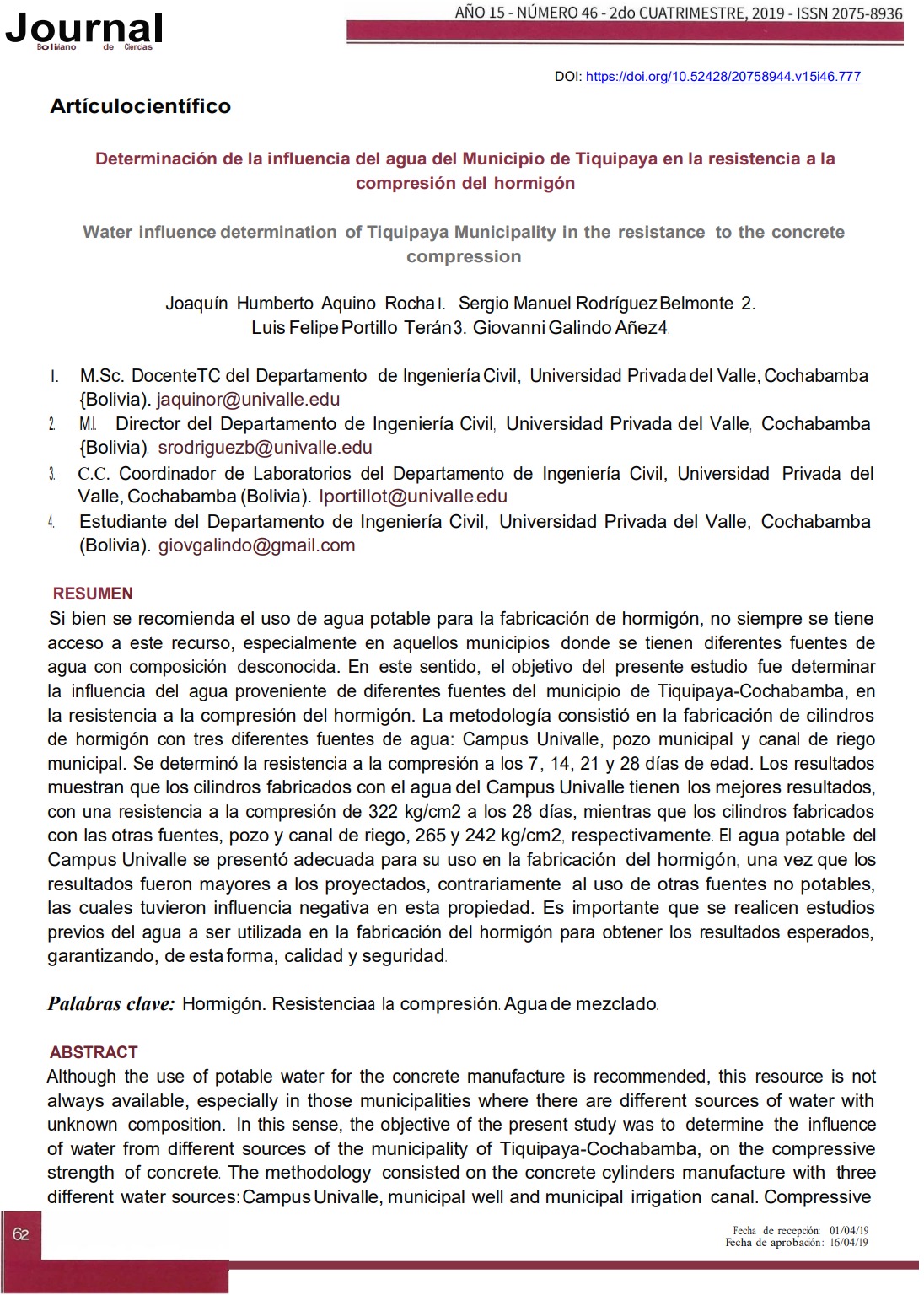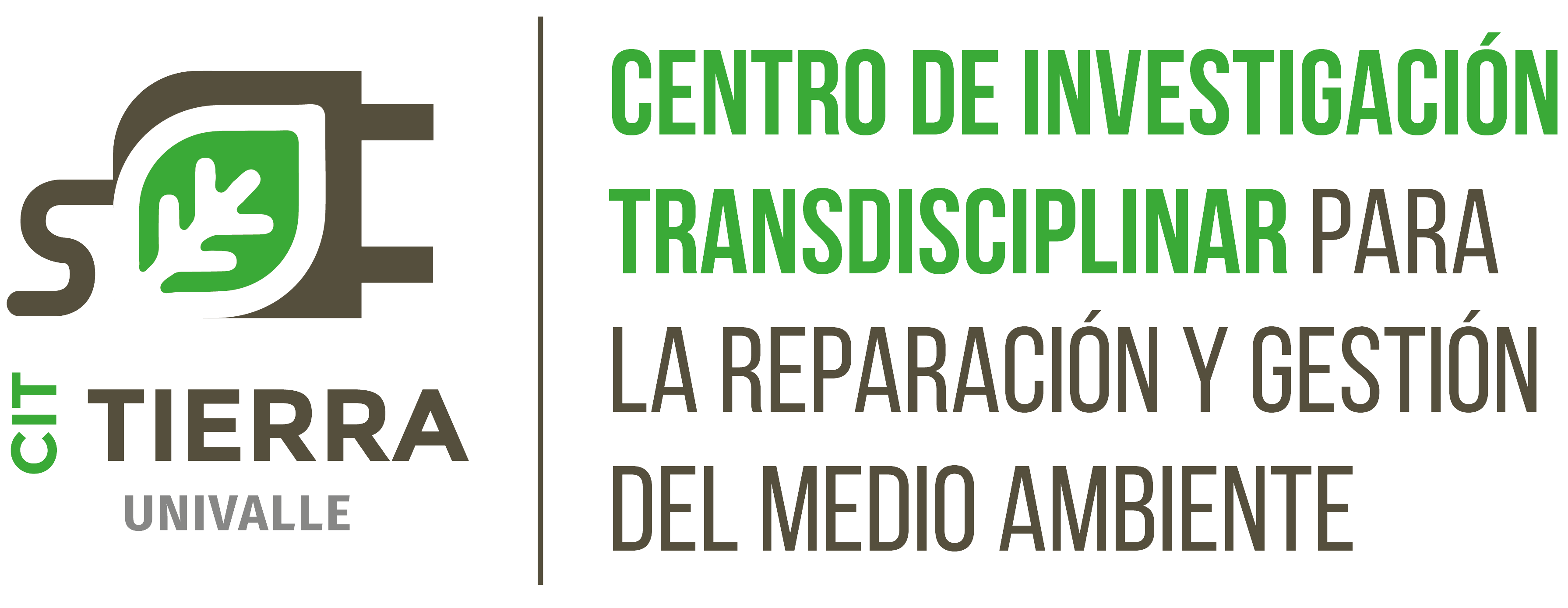Determinación de la Influencia del Agua del Municipio de Tiquipaya en la Resistencia a la Compresión del Hormigón
DOI:
https://doi.org/10.52428/20758944.v15i46.777Palabras clave:
Hormigón, Resistencia a la Compresión, Agua de MezcladoResumen
Si bien se recomienda el uso de agua potable para la fabricación de hormigón, no siempre se tiene acceso a este recurso, especialmente en aquellos municipios donde se tienen diferentes fuentes de agua con composición desconocida. En este sentido, el objetivo del presente estudio fue determinar la influencia del agua proveniente de diferentes fuentes del municipio de Tiquipaya-Cochabamba, en la resistencia a la compresión del hormigón. La metodología consistió en la fabricación de cilindros de hormigón con tres diferentes fuentes de agua: Campus Univalle, pozo municipal y canal de riego municipal. Se determinó la resistencia a la compresión a los 7, 14, 21 y 28 días de edad. Los resultados muestran que los cilindros fabricados con el agua del Campus Univalle tienen los mejores resultados, con una resistencia a la compresión de 322 kg/cm2 a los 28 días, mientras que los cilindros fabricados con las otras fuentes, pozo y canal de riego, 265 y 242 kg/cm2, respectivamente. El agua potable del Campus Univalle se presentó adecuada para su uso en la fabricación del hormigón, una vez que los resultados fueron mayores a los proyectados, contrariamente al uso de otras fuentes no potables, las cuales tuvieron influencia negativa en esta propiedad. Es importante que se realicen estudios previos del agua a ser utilizada en la fabricación del hormigón para obtener los resultados esperados, garantizando, de esta forma, calidad y seguridad.
Descargas
Citas
AASHTO - American Association of State Highway and Transportation Officials (2008). T 26-79: Standard method of test for quality of water to be used in concrete. Washington D. C.: AASHTO.
ACI - American Concrete lnstitute (2014). 318-14: Building Code Requirementsfor Structural Concrete. Detriot: ACI.
Al-Harthy, A.S., Taha, R., Abu-Ashour, J., Al-Jabri, K. y Al-Oraimi, S. (2005). Effect of water quality on the strength of flowable fill mixtures. Cement and Concrete Composites. 27: 33-39. https://doi.org/10.1016/j.cemconcomp.2004.01.005
Asadollahfardi, G., Delnavaz, M., Rashnoiee, V. y Ghonabadi, N. (2016). Use of treated domestic wastewater before chlorination to produce and cure concrete. Construction and Building Materials. 105: 253-261. https://doi.org/10.1016/j.conbuildmat.2015.12.039
ASTM - American society for testing and materials (2018a). C1602/C1602M-18: Standard Specification for Mixing Water Used in the Production of Hydraulic Cement Concrete. West Conshohocken: ASTM lnternational.
ASTM (1994). C184-94el - Standard Test Method for Fineness of Hydraulic Cement by the 150-µm (No.100) and 75-µm (No. 200) Sieves (Withdrawn 2002). West Conshohocken: ASTM nternational.
ASTM (2004). C127-04: Standard Test Method for Density, Relative Density (Specific Gravity), and Absorption of Coarse Aggregate. West Conshohocken: ASTM lnternational.
ASTM (2015a). C128-15: Standard Test Method for Relative Density (Specific Gravity) and Absorption of Fine Aggregate. West Conshohocken: ASTM lnternational.
ASTM (2015b). C143/C143M-15a: Standard Test Method for Slump of Hydraulic-Cement Concrete. West Conshohocken: ASTM lnternational.
ASTM (2016). C109/C109M-16a: Standard Test Method for Compressive Strength of Hydraulic Cement Mortars (Using 2-in. or [SO-mm] Cube Specimens). West Conshohocken: ASTM lnternational.
ASTM (2017a). C188-17: Standard Test Method for Density of Hydraulic Cement.West Conshohocken: ASTM lnternational.
ASTM (2017b). Cll7-17: Standard Test Method for Materials Finer than 75-µm (No. 200) Sieve in Mineral Aggregates by Washing. West Conshohocken: ASTM lnternational.
ASTM (2017c). C29/C29M-17a: Standard Test Method for Bulk Density ("Unit Weight") and Voids in Aggregate. West Conshohocken: ASTM lnternational.
ASTM (2018b). ASTM C94/C94M -18: Standard Specification for Ready-Mixed Concrete. West Conshohocken: ASTM lnternational.
ASTM (2018c). Cl91-18a: Standard Test Methods far Time of Setting of Hydraulic Cement by Vicat Needle. West Conshohocken: ASTM lnternational.
ASTM (2018d). C33/C33M-18: Standard Specification farConcreteAggregates. West Conshohocken: ASTM lnternational.
ASTM (2018e). C88/C88M-18: Standard Test Method far Soundness of Aggregates by Use of Sodium Sulfate or Magnesium Sulfate. West Conshohocken: ASTM lnternational.
ASTM (2018f). Cl92/Cl92M-18: Standard Practice far Making and Curing Concrete Test Specimens in the Laboratory. West Conshohocken: ASTM lnternational.
ASTM (2018g). C39/C39M-18: Standard Test Method far Compressive Strength of Cylindrical Concrete Specimens. West Conshohocken: ASTM lnternational.
Babu, G.R. y Ramana, N.V. (2018). Feasibility of wastewater as mixing water in cement. Materials today: Proceedings. 5(1) Part 1: 1607-1614. https://doi.org/10.1016/j.matpr.2017.11.253
Babu, G.R., Reddy, B.M. y Ramana, N.V. (2018). Quality of mixing water in cement concrete "a review". Materials today: Proceedings. 5(1) Part 1: 1313-1320. https://doi.org/10.1016/j.cemconres.2018.06.009 https://doi.org/10.1016/j.cemconres.2018.07.006
BSI - British Standard lnstitute (1980). BS 3148-1980: Method far test far water far making concrete. London: British standard institute.
BSI (2002). BS EN 1008:2002 - Mixing water far concrete. Specification far sampling, testing and assessing the suitability of water, including water recovered from processes in the concrete industry, as mixing water far concrete. London: British standard institute.
Cebeci, Z. y Saatci, M. (1989). Domestic Sewage as Mixing Water in Concrete. Materials Journal. 5: 503-506.
Chatveera, B., Lertwattanaruk, P. y Makul, N. (2006). Effect of sludge water from ready-mixed concrete plant on properties and durability of concrete. Cement and Concrete Composites. 28: 441-450. https://doi.org/10.1016/j.cemconcomp.2006.01.001
Cornak, B. (2018). Effects of use of alkaline mixing waters on engineering properties of cement mortars. European Journal of Environmental and Civil Engineering. 22(6): 736-754. https://doi.org/10.1080/19648189.2016.1217794
De Paula, H.M., De Oliveira llha, M.S., Andrade, L.S. (2014). Concrete plant wastewater treatment process by coagulation combining aluminum sulfate and Moringa oleifera powder. Journal of Cleaner Production, 76: 125-130. https://doi.org/10.1016/j.jclepro.2014.04.031
De Weerdt, K. y Justnes, H. (2015). The effect of sea water on the phase assemblage of hydrated cement paste. Cement and Concrete Composites. 55: 215-222. https://doi.org/10.1016/j.cemconcomp.2014.09.006
Fraternali, F., Spadea, S. y Berardi, V.P. (2014). Effects of recycled PET fibres on the mechanical properties and seawater curing of Portland cement-based concretes. Construction and Building Materials. 61: 293-302. https://doi.org/10.1016/j.conbuildmat.2014.03.019
IBNORCA - Instituto Boliviano de Normalización y Calidad. (1987). Norma Boliviana CBH 87. La Paz: IBNORCA, 293p.
IBNORCA (2005). Reglamento Nacional para el Control de la Calidad del Agua para Consumo Humano NB 512. La Paz: IBNORCA, 55p.
Meen a, K. y Luhar, S. (2019). Effect of wastewater on properties of concrete. Journal of Building Engineering. 21:106-112. https://doi.org/10.1016/j.jobe.2018.10.003
Mehta, K.P. y Monteiro, P. (2014). Concrete: Microstructure, Properties, and Materials. 4th ed. New York: McGraw-Hill. 704p. ISBN: 978-9-339-20476-l.
NEVILLE, A.M. (2000). Water Cinderella lngredient of Concrete. Concrete lnternational. 22(9): 66-71.
Neville, A.M. (2012). 5th ed. Properties of concrete. Harlow: Pearson Education. 872p. ISBN: 978-0-273-75580-7.
Noruzman, A.H., Muhammad, B., lsmail, M. y Abdul-Majid, Z. (2012). Characteristics of treated effluents and their potential applications for producing concrete. Journal of Environmental Management. 110: 27-32. https://doi.org/10.1016/j.jenvman.2012.05.019
Olutoge, F.A. y Amusan, G.M. (2014). The effect of sea water on compressive strength of concrete. lnternational Journal of Engineering Science lnvention. 3(7): 23-31.
Saxena, S. y Tembhurkar, A.R. (2018). lmpact of use of steel slag as coarse aggregate and wastewater on fresh and hardened properties of concrete. Construction and Building Materials. v.165: 126-237. https://doi.org/10.1016/j.conbuildmat.2018.01.030
Shi, Z., Shui, Z., Li, Q. y Geng, H. (2015). Combined effect of metakaolin and sea water on performance and microstructures of concrete. Construction and Building Materials. 74: 57-64. https://doi.org/10.1016/j.conbuildmat.2014.10.023

Descargas
Publicado
Cómo citar
Número
Sección
Licencia
Derechos de autor 2019 Joaquín Humberto Aquino Rocha, Sergio Manuel Rodríguez Belmonte, Luis Felipe Portillo Terán y Giovanni Galindo Añez

Esta obra está bajo una licencia internacional Creative Commons Atribución 4.0.
Los autores/as que publiquen en esta revista aceptan las siguientes condiciones:
- Los autores/as conservan los derechos de autor y ceden a la revista el derecho de la primera publicación, con el trabajo registrado con la licencia de atribución de Creative Commons 4.0, que permite a terceros utilizar lo publicado siempre que mencionen la autoría del trabajo y a la primera publicación en esta revista.
- Los autores/as pueden realizar otros acuerdos contractuales independientes y adicionales para la distribución no exclusiva de la versión del artículo publicado en esta revista (p. ej., incluirlo en un repositorio institucional o publicarlo en un libro) siempre que indiquen claramente que el trabajo se publicó por primera vez en esta revista.
- Se permite y recomienda a los autores/as a compartir su trabajo en línea (por ejemplo: en repositorios institucionales o páginas web personales) antes y durante el proceso de envío del manuscrito, ya que puede conducir a intercambios productivos, a una mayor y más rápida citación del trabajo publicado.














